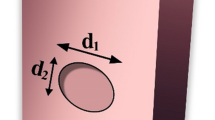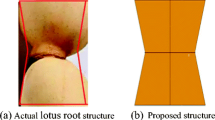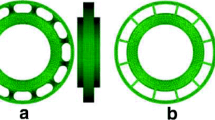Abstract
In this paper, multi-objective optimization of perforated square tubes is performed considering absorbed energy, peak crushing force and weight of the tube as three conflicting objective functions. In the multi-objective optimization problem (MOP), absorbed energy and peak crushing force are defined by polynomial models extracted using the software GEvoM based on the train and test data obtained from the numerical simulation of quasi-static crushing of the perforated square tubes using ABAQUS. To verify the numerical procedure, 16 different experimental tests are performed and then the experimental and numerical results are compared together. The comparison shows reasonable similarities between the numerical and experimental results. The MOP is solved using modified Non-dominated Sorting Genetic Algorithm II (NSGAII) and Multi-objective Particle Swarm Optimization (MOPSO) and then the solutions are combined for non-dominated sorting to obtain the non-dominated individuals of 3-objective optimization. 105 optimum points are extracted from the multi-objective optimization process. Finally, Nearest to Ideal Point (NIP) method and Technique for Ordering Preferences by Similarity to Ideal Solution (TOPSIS) method are employed to find trade-off optimum design points out of all non-dominated individuals compromising all three objective functions together.












Similar content being viewed by others
References
Amanifard N, Nariman-zadeh N, Borji M, Khalkhali A, Habibdoust A (2008a) Modelling and Pareto optimization of heat transfer and flow coefficients in microchannels using GMDH type neural networks and genetic algorithms. Int J Energy Convers Manag 49(2):311–325
Amanifard N, Nariman-Zadeh N, Farahani MH, Khalkhali A (2008b) Modelling of multiple short-length-scale stall cells in an axial compressor using evolved GMDH neural networks. Int J Energy Convers Manag 49(10):2588–2594
Arnold B, Altenh W (2004) Experimental observations on the crush characteristics of AA6061 T4 and T6 structural square tubes with and without circular discontinuities. Int J Crashworthiness 9(1):73–87
Arora JS (2012) Introduction to optimum design, Third Edition, Academic Press is an imprint of Elsevier
Atashkari K, Nariman-Zadeh N, Gölcü M, Khalkhali A, Jamali A (2007) Modelling and multi-objective optimization of a variable valve-timing spark-ignition engine using polynomial neural networks and evolutionary algorithms. Int J Energy Convers Manag 48(3):1029–1041
Bartczak B, Gierczycka-zbrożek D, Gronostajski Z, Polak S, Tobota A (2010) The use of thin-walled sections for energy absorbing components: a review. Arch Civ Mech Eng 10(4):5–19
Chenga Q, Altenhofa W, Lib L (2006) Experimental investigations on the crush behaviour of AA6061-T6 aluminum square tubes with different types of through-hole discontinuities. Int J Thin Walled Struct 44:441–454
Clerc M, Kennedy J (2002) The particle swarm–explosion, stability, and convergence in a multidimensional complex space. IEEE Trans Evol Comput 6(1):58–73
Coello Coello CA, Christiansen AD (2000) Multiobjective optimization of trusses using genetic algorithms. Comput Struct 75:647–660
Coello Coello CA, Van Veldhuizen DA, Lamont GB (2002) Evolutionary algorithms for solving multi-objective problems. Kluwer Academic Publishers, NY
Coello CAC, Pulido GT, Lechuga MS (2004) Handling multiple objectives with particle swarm optimization. IEEE Trans Evol Comput 8(3):256–279
Collette Y, Siarry P (2003) Multiobjective optimization: principles and case studies. Decision engineering series. Springer, Berlin
Ebbesen S, Kiwitz P, Guzzella L (2012) A generic particle swarm optimization matlab function. American Control Conference Fairmont Queen Elizabeth, Montréal, Canada
Fonseca CM, Fleming PJ (1993) Genetic algorithms for multi-objective optimization: formulation, discussion and generalization. In: Forrest S (ed) Proceedings of the fifth international conference on genetic algorithms. Morgan Kaufmann, San Mateo, pp 416–423
Guoxing L, Tongxi Y (2003) Energy absorption of structures and materials. Woodhead Publishing Ltd and CRC Press LLC, England
Ivakhnenko AG (1971) Polynomial theory of complex systems. IEEE Trans Syst Man Cybern SMC-1:364–378
Johnson W (1972) Impact strength of material. London, Edward Arnold, 760 London, UK
Johnson W, Reid SR (1978) Metallic energy dissipating systems. Appl Mech Rev 31(3):277–288
Jones N, Wierzbicki T (1983) Structural crashworthiness. Butterworth and Co. Publishers, London
Kennedy J, Eberhart R (1995) Particle swarm optimization, in Neural Networks. IEEE Int Conf 4:1942–1948
Khakhali A, Darvizeh A, Masoumi A, Nariman-Zadeh N, Shiri A (2010) Robust design of S-shaped box beams subjected to compressive load, mathematical problems in engineering, Volume 2010. Article ID 627501, 18 p
Khakhali A, Nariman-zadeh N, Darvizeh A, Masoumi A, Notghi B (2010b) Reliability-based robust multi-objective crashworthiness optimisation of S-shaped box beams with parametric uncertainties. Int J Crashworthiness 15(4):443–456
Khakhali A, Darvizeh A, Masoumi A, Nariman-zadeh N (2011) Experimental and numerical investigation into the quasistatic crushing behaviour of the S-shape square tubes. J Mech 27(04):585–596
Khalkhali A, Safikhani H (2011) Pareto based multi-objective optimization of cyclone vortex finder using CFD, GMDH type neural networks and genetic algorithms, engineering optimization, Volume 44, Issue 1, 2012
Khalkhali A, Farajpoor M, Safikhani H (2011) Modeling and multi-objective optimization of forward-curved blades centrifugal fans using CFD and neural networks. Trans Can Soc Mech Eng 35(1):63–79
Liu GP, Kadirkamanathan V (1999) Multi-objective criteria for neural network structure selection and identification of nonlinear systems using genetic algorithms. IEE Proc Control Theory Appl 146(5):373–382
Mamalis AG, Manolakos DE, Spentzas KN, Ioannidis MB, Koutroubakis S, Kostazos PK (2009) The effect of the implementation of circular holes as crush initiators to the crushing characteristics of mild steel square tubes: experimental and numerical simulation. Int J Crashworthiness 14(5):489–501
Nariman-Zadeh N, Darvizeh A, Jamali A (2006) Pareto optimization of energy absorption of square aluminum columns using multi-objective genetic algorithms. Proc Inst Mech Eng B J Eng Manuf 220(2):213–224
Pareto V (1896) Cours d’economic politique. Rouge: Lausanne, Switzerland
Shi Y, Eberhart RA (1998) modified particle swarm optimizer. In Proceedings of the IEEE International Conference on Evolutionary Computation, IEEE Press, Piscataway, p 69–73
Srinivas N, Deb K (1994) Multiobjective optimization using nondominated sorting in genetic algorithms. Evol Comput 2(3):221–248
Tavoli A, Nariman-zadeh N, Khalkhali A, Mehran M (2006) Multi-objective optimization of abrasive flow machining processes using polynomial neural networks and genetic algorithms. Int J Mach Sci Technol 10(4):491–510
Author information
Authors and Affiliations
Corresponding author
Appendix A
Appendix A
Corresponding polynomial representation for absorbed energy of types A, B, C and D obtained using GEvoM are as follows:
For Type A:
For Type B:
For Type C:
For Type D:
Similarly, the corresponding GEvoM polynomial representations to model the peak crushing force of types A, B, C and D are in the form of:
For Type A:
For Type B:
For Type C:
For Type D:
Rights and permissions
About this article
Cite this article
Khalkhali, A., Mostafapour, M., Tabatabaie, S.M. et al. Multi-objective crashworthiness optimization of perforated square tubes using modified NSGAII and MOPSO. Struct Multidisc Optim 54, 45–61 (2016). https://doi.org/10.1007/s00158-015-1385-y
Received:
Revised:
Accepted:
Published:
Issue Date:
DOI: https://doi.org/10.1007/s00158-015-1385-y




